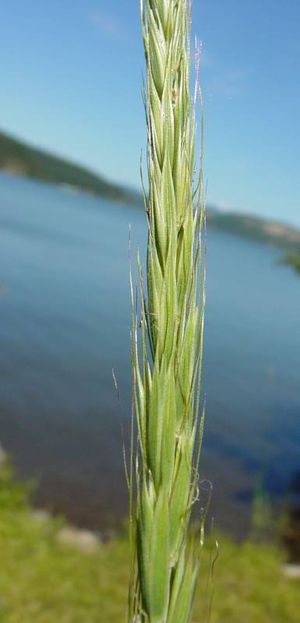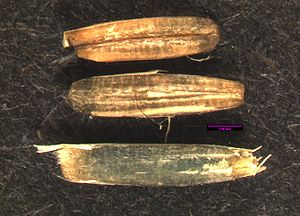Difference between revisions of "Elymus glaucus"
(→Image Gallery) |
|||
| Line 1: | Line 1: | ||
| − | * | + | * Scientific Name: ''Elymus'' ''glaucus'' |
* Family: Poaceae | * Family: Poaceae | ||
* Common Names: blue wild-rye | * Common Names: blue wild-rye | ||
Revision as of 20:50, 20 March 2021
- Scientific Name: Elymus glaucus
- Family: Poaceae
- Common Names: blue wild-rye
- Codon: ELYGLA
Contents
Taxonomy
| Scientific classification | |
|---|---|
| Kingdom: | Plantae |
| Subkingdom: | Viridiplantae |
| Phylum: | Tracheophyta |
| Subphylum: | Spermatophytina |
| Class: | Magnoliopsida |
| Subclass: | Lilianae |
| Order: | Poales |
| Family: | Poaceae |
| Genus: | Elymus L. |
| Species: | Elymus Glaucus Buckley |
| Synonyms | |
| |
Description
Blue wildrye is a large perennial bunchgrass. It is very tall (up to 5 feet) with an upright growth habit and just a few stems per plant. It is similar in stature and growth habit to slender wheatgrass. The leaf blades are thin and flat, ranging from 4-12mm (.2-.5 inch) wide. Leaf color changes from green to blue green, with a white waxy coating. Frosts induce dormancy.
Bloom Period
May-July
Distribution
Blue wildrye is found from California to Alaska and also the Great Plains and northern Mexico. Check a reputable database for current distribution.
Habitat
Open areas, native prairie, chaparral, woodland and forest. Blue wildrye is tolerant of partial shade and soil textures ranging from loam to clay, moist to dry, and well-drained soils. Low moisture use – high drought tolerance.
This plant has demonstrated moderate sensitivity to saline soils. Its successional Status is that blue wildrye is typically favored by disturbance.
Uses
Site Rehabilitation: A desirable species for use in erosion control. Blue wildrye is good for streambank restoration, meadow and swale seeding. It is also excellent for reseeding burned or disturbed areas in oak woodland or forest. Blue wildrye is not recommended to be seeded alone in revegetation plantings, and it should not make up more than 50% of the seed mix.
Wildlife: Blue wildrye can also provide excellent wildlife habitat for mammals, birds, and waterfowl. It provides good forage early in the season, but later, may be too coarse and stemmy.
Landscaping: The attractive, blue-green foliage adds value to commercial landscaping projects.
First Nations: Blue wildrye has similar uses as creeping wild rye, primarily as a cereal grain. It is less desirable for basketry as the nodes are thick, but this does not exclude its use in some baskets. Similar to creeping wildrye, there may be some ceremonial uses of blue wildrye.
Propagation
see Plant Materials Technical Note No. 17, from USDA in Portland, OR to Natural Resources Conservation Service ("Seed Production of Blue Wildrye", April 1996)
Seed
Seed sample from: 2010
Average Measurement including husk and awn: 29.8 x 1.2 x 0.9
Measurement Range including husk and awn: L: 22 – 35, W: 1 – 1.5, D: 0.5 – 1
Average Measurement without husk or awn: 5.3 x 1 x 1
Measurement Range without husk or awn: L: 5 - 5.5, W: 0.9 – 1.1, D: 0.9 – 1
Features
Shape: Awn is straight and is 5 – 6 times as long as seed body. Awn is very finely toothed.
Other Structures: Inner seed has deep longitudinal sulcus on one side and a few fine longitudinal lines on the opposite seed face.
Color: Husks off white to tan, papillose with a slight sheen. Hilium is a darker brown color. Seed is tan at the ends, and blue to green in the middle.
Surface: Seed surface is smooth and matte.
Latitudinal Cross Section: elliptical 
Longitudinal Cross Section: elliptical ![]()
Photo Gallery
References
- USDA, NRCS. 2012. Elymus glaucus Buckley ssp. glaucus – blue wildrye USDA PLANTS Profile, PLANTS Database (http://plants.usda.gov/java/profile?symbol=elgl, 7 May 2012). National Plant Data Team, Greensboro, NC 27401-4901 USA. Retrieved 05/14/2012.



